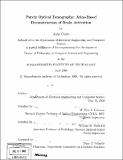Purely optical tomography : atlas-based reconstruction of brain activation
Author(s)
Custo, Anna
DownloadFull printable version (62.28Mb)
Alternative title
Atlas-based reconstruction of brain activation
Other Contributors
Massachusetts Institute of Technology. Dept. of Electrical Engineering and Computer Science.
Advisor
W. Eric L. Grimson and William M. Wells, III.
Terms of use
Metadata
Show full item recordAbstract
Diffuse Optical Tomography (DOT) is a relatively new method used to image blood volume and oxygen saturation in vivo. Because of its relatively poor spatial resolution (typically no better than 1-2 cm), DOT is increasingly combined with other imaging techniques, such as MRI, fMRI and CT, which provide high-resolution structural information to guide the characterization of the unique physiological information offered by DOT. This work aims at improving DOT by offering new strategies for a more accurate, efficient, and faster image processor. Specifically, after investigating the influence of Cerebral Spinal Fluid (CSF) properties on the optical measurements, we propose using a realistic segmented head model that includes a novel CSF segmentation approach for a more accurate solution of the DOT forward problem. Moreover, we outline the benefits and applicability of a Diffusion Approximation-based faster forward model solver. We also describe a new registration algorithm based on superficial landmarks which is an essential tool for the purely optical tomographic image process proposed here. A purely optical tomography of the brain during neural activity will greatly enhance DOT applicability and provide many advantages, in the sense that DOT low cost, portability and non-invasiveness would be fully exploited without the compromises due to the MRI role in the DOT forward image process. We achieve a purely optical tomography by using a generalized head model (or atlas) in place of the subject specific anatomical MRI. We validate the proposed imaging protocol by comparing measurements derived from the DOT forward problem solution obtained using the subject specific anatomical model versus these acquired using the atlas registered to the subject, using a database of 31 healthy human. subjects, and focusing on a set of 12 functional regions of interest. (cont.) We conclude our study presenting data obtained from 3 experimental subjects having undergone median nerve stimuli. We apply our purely optical tomography protocol to the 3 subjects and analyze the observations derived from both the DOT forward and inverse solutions. The experimental results demonstrate that it is possible to guide the DOT forward problem with a general anatomical model in place of the subject's specific head geometry to localize the macro anatomical structures of neural activity.
Description
Thesis (Sc. D.)--Massachusetts Institute of Technology, Dept. of Electrical Engineering and Computer Science, 2008. Includes bibliographical references (p. 151-161).
Date issued
2008Department
Massachusetts Institute of Technology. Department of Electrical Engineering and Computer SciencePublisher
Massachusetts Institute of Technology
Keywords
Electrical Engineering and Computer Science.